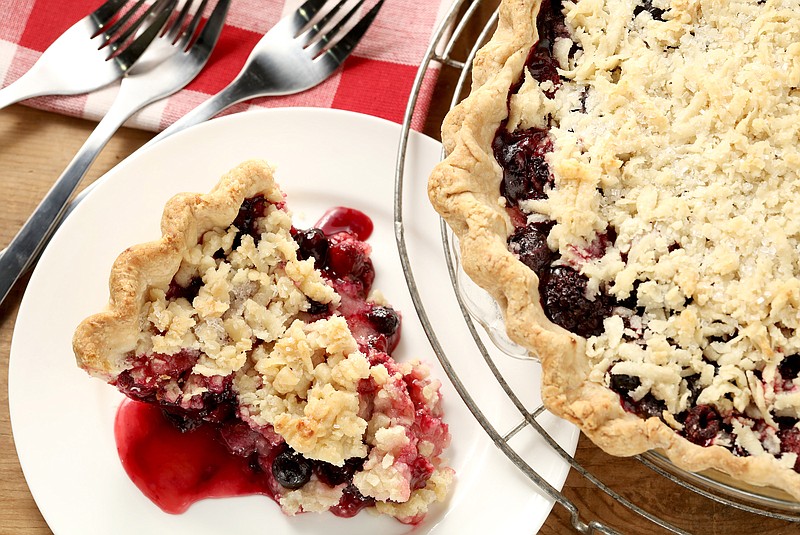It's not summer without pie. Fruit pie, specifically. As the season's fruit, each in its turn, marches through farmers markets, aligned in battalions in juice-stained wood-strip baskets, strawberries then cherries then apricots then peaches then blueberries, we think about eating them between two pieces of crisp, rich pastry.
Would you like a juicy fresh peach for dessert? Or the fruit, sliced, tossed with sugar and baked into a deeper version of itself? Well, pie, thank you.
And forget the ice cream. And the whipped cream. The only accompaniment a good pie needs is a fork-or a cup of coffee when you have a piece for breakfast.
Funny story about pie. We're on vacation in northern Ontario and about to dig into a bumbleberry pie from a local bakery. And the preteen nephew asks, "What's a bumbleberry?" We all laugh. But really, how was he to know? He understands blueberries, blackberries, raspberries. To him, bumbleberry just sounds like another berry. But bumbleberry describes a jumble of any berries you'd like to throw into that pie crust.
Flash-forward 10 years or so to this summer's trip. We're having bumbleberry jam from that same bakery, and the just-graduated-from-college nephew asks again, "What's a bumbleberry?" More laughter.
OK, Jake, remember this: Bumbleberry is like summer itself, easy breezy, just go with the flow. You've got blueberries, blackberries and raspberries, but no strawberries? No problem. Tumble them in. There's no pattern. Just like the perfect summer day.
As those days wind down, we offer this pie, a take on bumbleberry from the 2004 book "Pie" by Ken Haedrich. Our version proves the adaptability point in that we've churned up Haedrich's mix to fit late summer fruit.
And his method offers another easy-breezy advantage: The top crust is grated, as quick as mozzarella, over the pie. What could be simpler?
DUNDEE ARMS INN BUMBLEBERRY PIE
Prep: 25 minutes, plus chilling
Bake: 55-60 minutes
Makes: 8 servings
Ken Haedrich includes this pie from a Prince Edward Island inn in his book "Pie: 300 Tried-and-True Recipes for Delicious Homemade Pie." That recipe includes fresh rhubarb and strawberries (1 cup each, sliced), but we choose to use all berries, adding blackberries and increasing the amounts of other berries.
1 recipe basic flaky pie pastry, double crust, refrigerated 1 hour
1 1/3 cups fresh raspberries
1 1/3 cups fresh blueberries
1 1/3 cups fresh blackberries
1 cup sugar
2 tablespoons fresh lemon juice
1/3 cup flour
2 tablespoons cold unsalted butter, cut into small pieces
1 tablespoon coarse sugar (aka sanding sugar) or 1 tablespoon granulated sugar
1. On a sheet of lightly floured waxed paper, roll the larger half of the dough pastry into a 13-inch circle with a floured rolling pin. Invert the pastry over a 9 1/2-inch deep dish pie pan; center and peel off the paper. Tuck pastry into pan, without stretching it. Sculpt and flute edge into an upstanding ridge. Place in freezer, 15 minutes; also place remaining unrolled pastry in the freezer. Heat oven to 400 degrees.
2. Combine the berries, sugar and lemon juice in a bowl; toss gently to mix. Add flour; toss gently again. Turn the filling into the chilled pie shell, smoothing the top of the fruit with a spoon. Dot the top of the filling with the butter.
3. Using the large holes of a box grater, grate the other half of the pastry directly over the fruit, as if it were a block of cheese. Using a fork, gently move the gratings here and there for an even covering. Sprinkle the coarse sugar over the top.
4. Bake pie on the center rack, 30 minutes. Reduce oven temperature to 375 degrees and rotate pie 180 degrees so that the part that faced the back of the oven now faces forward. Slide a foil-lined baking sheet onto the rack below to catch any spills. Bake until the top is golden brown and the juices bubble thickly around the edge, 25-30 minutes.
5. Transfer pie to a wire rack; let cool at least 2 hours before serving.
Nutrition information per serving: 578 calories, 28 g fat, 14 g saturated fat, 50 mg cholesterol, 77 g carbohydrates, 33 g sugar, 6 g protein, 295 mg sodium, 5 g fiber
BASIC FLAKY PIE PASTRY
This dough from "Pie" makes enough for a double-crust 9-inch standard pie or 9 1/2-inch deep-dish pie.
Put 3 cups flour, 1 tablespoon sugar and 1 teaspoon salt in a food processor. Pulse several times to mix. Scatter 1 stick (1/2 cup) cold unsalted butter, cut into 1/4-inch pieces, over the dry ingredients. Pulse 5 or 6 times to cut butter in. Fluff with a fork, lifting mixture up from bottom of bowl. Scatter 1/2 cup cold lard (or nonhydrogenated vegetable shortening), cut into pieces, over the mixture. Pulse 5 or 6 times. Fluff again. Drizzle 1/4 cup cold water over mixture; pulse 5 or 6 times. Fluff again. Sprinkle on 1/4 cup more cold water, if needed. Pulse 5 or 6 times more, until clumps begin to form. Dough should look like coarse crumbs. Dump contents into a large bowl. Test the pastry by squeezing some between your fingers. If it seems a little dry and not quite packable, drizzle with 1 teaspoon or so of cold water; work it in with your fingers.
Pack the dough into 2 balls, one ball slightly larger than the other. That is your bottom crust. Knead each ball once or twice. Flatten into 3/4-inch thick disks on a lightly floured surface. Wrap each in plastic; refrigerate 1 hour or overnight before rolling.

